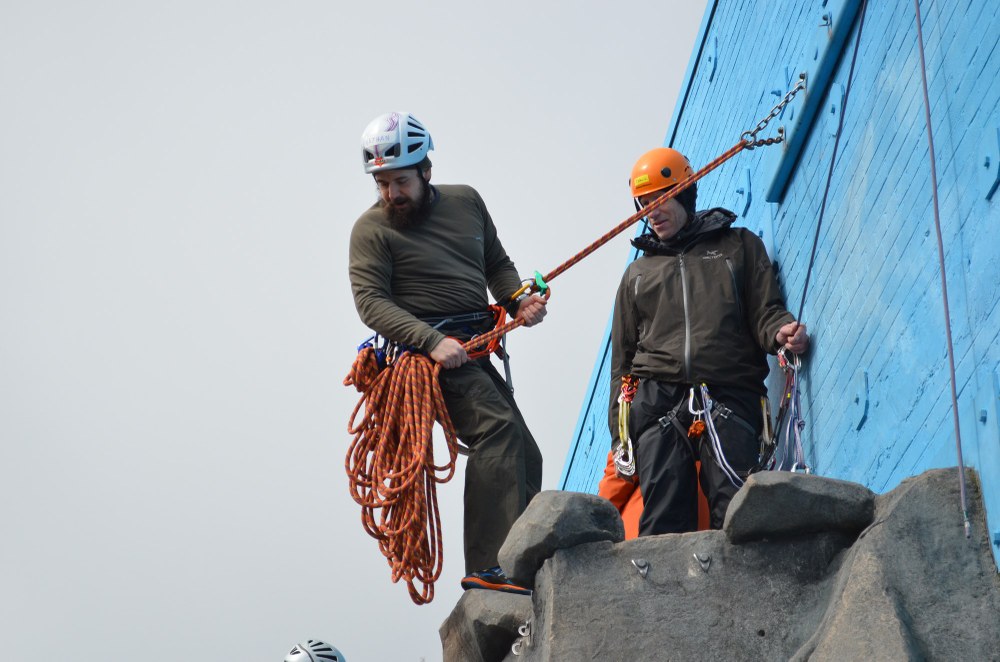
Seattle Program Center, South Plaza - September 20
FIELD TRIP LEADER
Subject suffered 2nd degree rope burns on fingers due to losing control of assisted rappel during two-person self-rescue simulation. Location was the South Plaza climbing area at the Mountaineers Clubhouse. First Aid was cold water bath for several hours. Formal medical treatment not required/sought. Subject was able to participate fully in seminar next day wearing gloves, full recovery within one week.
Subject and Partner were seminar participants, and were closely watched by a Seminar Assistant Instructor who was on a static line about 6 feet away. The Assistant Instructor maintained the same elevation as the Subject through use of ascenders/gri-gri.
Subject was practicing their first multi-pitch transition of assisted rappel. The Subject and Partner descended from the top of the 25' tall wall to a lower anchor 12' above ground. The pair clipped into lower anchor with personal anchors (PA's), and the Subject then transitioned the master point of rappel spider onto lower anchor with a 7mm cordellette-based Munter-Mule acting as a Load Releasing Hitch.
Subject removed the rope from the upper rappel, and setup to continue the assisted rappel to the ground, utilizing an accessory cord loop to form a 2-wrap autobloc on the harness leg loop. Once ready to rappel, the Subject relocated the PA's from the anchor to the rappel device carabiner.
The Subject then released the Mule knot on the Load Releasing Hitch, but immediately lost control of the descent speed. The Subject and Partner descended to the ground at walking speed, with the Subject gripping the rope and cordellete above the load releasing hitch in an attempt to stop. Once the Partner reached the ground, the load on the rappel device lessened, and the autobloc then locked, which stopped the Subject about 3" above the ground. Other seminar participants lifted the Subject so that the autoblock could be loosened and the Subject brought to the ground.
Findings:
- The Load Releasing Hitch was a Munter-Mule. It was oriented upside down from how taught, meaning that the hitch was on the bottom, so the operator needed to reach above the hitch to provide maximum braking. This is an unnatural position, and the Subject was unable to hold the position, thus opening the Munter, and providing less friction than needed to control descent. This was the initial failure of the system.
- The autobloc had only 2 wraps. 3 wraps for a single person load is commonly taught, but we do not specify a certain number of wraps for a 2 person load. The 2 wrap autobloc did not stop the descent of the 2 person load, however it did limit the speed of descent. This was the secondary failure of the system.
- No backup knot was installed. Participants are instructed to install a backup before unclipping the PA's, and to remove the backup only after a controlled descent is confirmed. Although a backup knot would not have entirely prevented the injury, it would have lessened it, and in an alpine environment, would have likely saved lives.
Changes made subsequently during the course:
- Reinforce that backup knots are mandatory in Self-Rescue.
- Reinforce that the if a cordellette-based Munter-Mule is chosen as a Load Releasing Hitch, it should utilize a Super-Munter or a re-direct for the Assisted Rap.
- Reinforce that the Autoblock is not a guaranteed method to prevent descent, and discuss what amount of wraps are needed for control of a 2 person load.
- An anchor approximately 8' above the ground was used in lieu of the anchor 12' above the ground.
 David Shema
David Shema